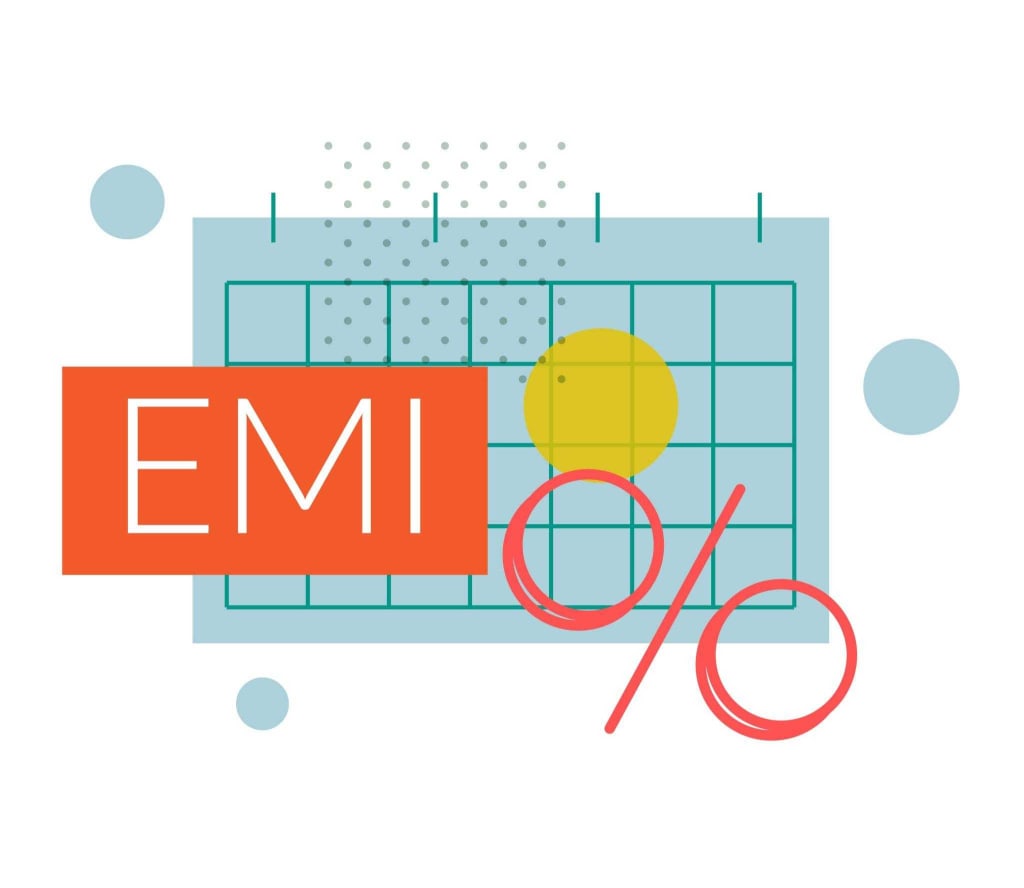What is an EMI (Equated Monthly Installment)?
What is an EMI (Equated Monthly Installment)?

Overview
Loans become an essential element of our daily life. We take out loans for particular reasons — whether it's to purchase a house, a vehicle, or send our children overseas for college – loans help us achieve some very significant life goals. Having said that, when we talk about loans, the term "EMI" comes up since the money we borrow must be returned to the lender with interest.
What is an EMI (Equated Monthly Installment)?
The amount paid by a borrower to a lender on a certain date each calendar month is referred to as the EMI.
We hear the word EMI all the time in our daily lives. Whether you have a student loan, a house loan, a vehicle loan, or another sort of loan, the monthly installments you must make to the lender are referred to as EMI or Equated Monthly Installment. Many items, such as a mobile phone or a laptop, may now be purchased on the EMI plan by paying the minimum needed amount at the time of purchase and then paying the remaining amount in the form of an EMI. But what exactly does the EMI entail, and how does it help you as a borrower? To grasp this, let's go through the basics of Equated Monthly Installment (EMI) and how it works.
What exactly is an Equated Monthly Installment (EMI)?
The equivalent Monthly Installment (EMI), as it is often called, is a predetermined amount of payment paid by a borrower to the lender each month on a certain date that is pre-determined at the time of providing the loan, product, or service. These payments are applied to the principle and interest amounts, allowing the loan to be paid off in phases over a defined period of years. The concept of Equated Monthly Installments, or EMI, works particularly well with certain types of loans, such as auto loans, real estate mortgages, student loans, and many others, in which the borrower makes fixed monthly payments to the lender over a period of several years in order to pay off the entire loan amount.
The Equated Monthly Installments, or EMI, the technique is frequently used to pay off loans since it informs borrowers of a specific amount to be paid every month on a pre-determined date. Knowing the amount to be paid each month provides borrowers peace of mind since they are not compelled to pay the whole amount all at once, and they can manage their money each month while keeping the predetermined amount in mind.
What is an Equated Monthly Installment, often known as an EMI?
The Equated Monthly Installment, or EMI, is not the same as variable payment plans, in which borrowers can pay a varying amount of money based on their convenience. In EMI plans, a predetermined sum is determined and is to be paid on a regular basis, i.e. on a certain day each month. This Equated Monthly Installment (EMI) plan attempts to improve financial management for both the borrower and the lender while also putting pressure on the borrower.
In certain ways, the Equated Monthly Installment (EMI) plan helps both the borrower and the lender, which is why it is the most popular loan payment plan when compared to any other payment plan. The borrower benefits from using EMI since they will know the set amount of payment to be paid each month and will be able to manage their savings and expenditures accordingly. The lenders, on the other hand, gain from EMI since it provides them with a consistent stream of income from the monthly EMI payments made by the borrowers.
As the Equated Monthly Installment, or EMI, has grown in popularity, it is now available for a variety of additional products and services, as well as online shopping. You may simply get your desired phone, laptop, or other pricey item by utilizing an EMI plan and paying the entire amount in monthly payments.
What Affects EMI and Why?
Principal borrowed: This is the total amount of money borrowed by the person.
Rate of interest: This is the interest rate that is charged on the amount borrowed.
Tenure of the loan: This is the agreed-upon loan repayment schedule between the borrower and the lender.
Fixed or floating type of loan: The EMI is affected by the "Rest" component if the interest rate is variable.
What is the timetable for amortization?
The amortization schedule is a detailed table that shows all of the loan specifics as well as how the EMI payments are broken down. It displays how much of each EMI is used to pay the principal and interest until the loan is paid off.
The amortization schedule explains how your loan will be paid off over time and contains information such as:
EMI amount
Principal borrowed
Interest cost of each EMI payment
What is an EMI (Equated Monthly Installment) and how does it work?
1. Flat Rate Method
The principal loan amount and the interest on the principal are added in this technique. After that, the total is divided by the loan term and multiplied by the number of months in a year.
A Flat Rate EMI is an example of a loan with a fixed interest rate.
Assume you have a 10-year house loan with a principal loan amount of $10,000,000.00 and an interest rate of 8%. Using the flat-rate technique, your EMI is computed as follows:
(₹10, 00,000 + (₹10, 00,000 x 10 x 0.08)) / (10 x 12)
The EMI amount is ₹15,000
2. Reducing Balance Method
calculating the EMI using the reducing balance method, let's use the same example.
(P x I) x ((1 + r)n)/ (t x ((1 + r)n)- 1)
P represents the principal borrowed, I represents the yearly interest rate, r represents the periodic monthly interest rate, n represents the total number of monthly payments, and t is the number of months in a year.
Reducing Balance Example EMI
Let us continue with the same example to calculate the EMI using the lowering balance approach.
((₹10, 00,000 x (0.08)) x (1 + (0.08 / 12)) 120) / (12 x (1 + (0.08/12)) 120 – 1).
The EMI amount is ₹12,133
What Are the Various Kinds of Loan Interest Rates?
Fixed interest rate
The interest rate on this form of loan remains constant during the loan's term. As a result, the EMI stays unchanged. Fixed interest rates are typically 1% to 2% higher than variable interest rates. Because the interest rate does not vary, the advantage of a fixed interest rate is that you know exactly what your future EMIs will be until your loan is paid off.
Floating or variable interest rate
The interest rate in this case is liable to vary based on market developments. Because the variable interest rate is dependent on the lending institutions' base rate, it adjusts automatically when the base rate changes.
Is a fixed or variable interest rate better? Which one is better?
The fixed interest rate ensures that your EMI remains constant throughout the loan's term. So, if you don't want to face the risk of rising interest rates and prefer to know what your monthly payments will be, a fixed interest rate is the ideal option for you.
However, if your loan is for a lengthy period of time, say 20 to 30 years, a variable interest rate is preferable. Also, if you know that the base rate will remain constant or even fall over time, it makes sense to use a floating rate. You may then arrange your prepayments and minimize your loan's interest rate. This translates into significant savings.
Is the EMI Variable Throughout the Loan Term?
Your EMI is determined by criteria such as loan amount, loan tenure, and interest rate.
The EMI you pay may fluctuate over the course of the loan term if certain conditions are met, such as:
Progressive EMIs: Some banks and lending organizations allow you to make progressive EMI payments. In this case, you must pay a fixed EMI for a certain length of time, after which the payment amount increases. This sort of facility is typically used for long-term lending.
Loan Prepayment: Some banks enable you to pay off a portion of your loan in one single sum, much ahead of your regular payment date. When you prepay a portion of your loan, your principal amount reduces, decreasing your interest rate and lowering the EMI amount required.
Floating interest rate: The EMI amount remains constant with fixed interest rate loans. However, if you have chosen a variable interest rate, the interest rate adjusts according to market circumstances, causing the EMI amount payable to alter.
What exactly is an EMI calculator?
An EMI calculator is an online application that calculates and compares EMIs for various loans and tenures. The computation takes three elements into account: loan tenure, interest rate, and loan amount.
It computes the EMI amount you must pay each month in seconds.
You will learn the total amount you must pay as well as the interest rate.
It assists you in determining the optimum loan term for you.
Once you know how much your EMI will be, you can arrange your budget appropriately.
About the Creator
Enjoyed the story? Support the Creator.
Subscribe for free to receive all their stories in your feed. You could also pledge your support or give them a one-off tip, letting them know you appreciate their work.





Comments
There are no comments for this story
Be the first to respond and start the conversation.